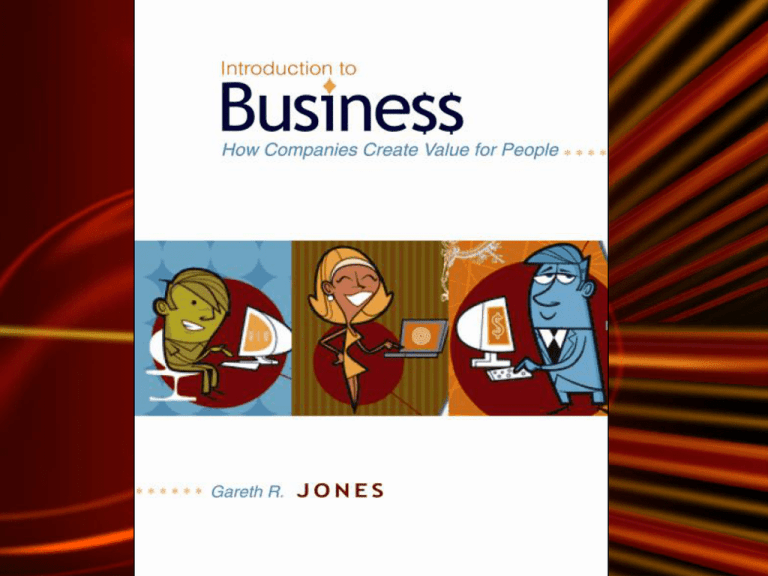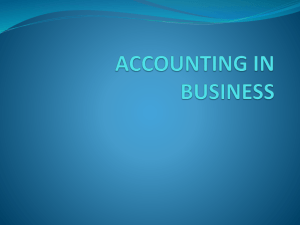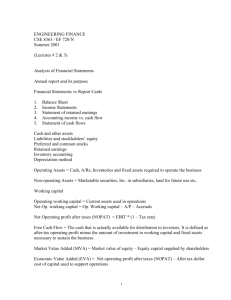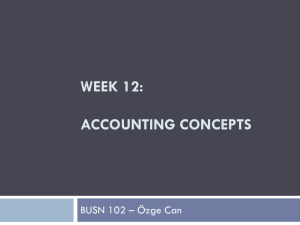
Chapter Fourteen
Accounting: Measuring how
Efficiently and Effectively
Resources Are Creating Value
and Profit
McGraw-Hill/Irwin
Introduction to Business
© 2007 The McGraw-Hill Companies, Inc., All Rights Reserved.
Learning Objectives
1.
2.
3.
Explain how the success of a company’s business
model can be measured by financial accounts and
describe the various kinds of activities that
accountants perform.
Analyze a company’s balance sheet and describe
how it balances the assets a company owns
against the capital owed to its creditors and
stockholders.
Explain how the income statement is used to
measure a company’s bottom line profit and the
various costs and expenses that must be
deducted to arrive at this total.
14 - 3
Learning Objectives
4. Understand why the need for cash, as well as
profit, affects a company’s business model and
how the cash flow statement measures the
cash that flows into and out of a company.
5. Appreciate how financial ratios can be used to
analyze the information in a company’s
financial statements and how they help both
managers and investors evaluate a company’s
current and future profitability.
14 - 4
The Nature of Accounting
• Accounting
- the process of collecting financial data,
organizing and analyzing it using agreedupon accounting rules, and reporting the
results in financial statements
14 - 5
The Nature of Accounting
• Accounting system
- the financial information system a company
uses to measure, record, analyze, and
report all the transactions involved in its
value-creation process
14 - 6
Question?
What is the record-keeping activities needed
to monitor and track all of the financial
transactions related to making and
selling goods and services?
A. Bookkeeping
B. Accounting
C. Accounting systems
D. Double-entry journals
14 - 7
Types of Accounting Activities
• Bookkeeping
- the record-keeping activities needed to
monitor and track all of the financial
transactions related
to making and selling
goods and services
14 - 8
Types of Accounting Activities
• Depreciate
- the act of calculating the reduced value of
the assets a company uses to make and
sell its products
14 - 9
Accounting Activities
Figure 14.1
14 - 10
The Rules of Accounting: GAAP
• Generally accepted accounting
principles
- a set of accounting rules and procedures
U.S. companies must follow to ensure their
financial standing is being reported
accurately and honestly
14 - 11
Types of Accountants
• Certified public accountants (CPAs)
- people who have taken 150 semester
hours of accounting courses and have
passed the CPA exam administered by the
American Institute of Certified Public
Accountants
Steps to become a CPA can be found at cpa-exam.org
14 - 12
Types of Accountants
• Audit
- the formal
evaluation of the
fairness and
reliability of a
company’s
financial
statements
14 - 13
Types of Accountants
• Managerial accountants
- accountants who specialize in preparing
and analyzing the financial data used by
managers
• Financial accountants
- accountants who specialize in preparing
financial data, following GAAP rules, for
use by outside stakeholders
14 - 14
Accounting Concepts and Financial
Statements
• The Balance Sheet
• The Income Statement
• The Statement of Cash Flows
14 - 15
The Balance Sheet
• Balance sheet
- a summary of the financial condition of a
business at the end of a day of a specific
reporting period
14 - 16
The Balance Sheet
• Assets
- the productive resources a company owns
as well as all of its financial investments
• Liabilities
- the financial obligations a company incurs
by borrowing money or buying productive
resources on credit
14 - 17
The Balance Sheet
• Stockholders’ equity
- the total capital invested in a company over
a time as well as the past profits it has
retained in its business
14 - 18
The Basic Accounting Equation
Assets - Liabilities = Owners’ Equity
14 - 19
The Basic Accounting Equation
• Double entry bookkeeping
- a method of recording the dual effects of a
business’s financial transaction so that the
company’s assets, liabilities, and owners’
equity are always in balance
14 - 20
Assets
• Liquidity
- assets listed in the firm’s balance sheet in
order of how fast they can be converted
into cash
• Current assets
- the total value of a company’s cash,
accounts receivable, inventory, and prepaid
expenses
14 - 21
Liabilities
• Current liabilities
- debts that are
payable within one
year’s time,
including accounts
payable and accrued
expenses
14 - 22
Stockholders’ Equity
• Total equity
- the sum of the capital stock invested in a
business in addition to its retained earnings
14 - 23
The Income Statement
• Income statement
- the financial report that summarizes the
results of a company’s profit-making
activities in a specific time period
• Bottom-line profit
- the amount of net income, profit, or
earnings a company reports on the bottom
line of its income statement
14 - 24
Sales, Expenses, and Profit
Figure 14.3
14 - 25
The Income Statement
• Accrual basis of accounting
- the principle that a company’s income
statement should reflect the revenue
received when the company makes a sale,
not when payment is actually received
14 - 26
Question?
What is a company’s total profit after
deducting the cost of the goods it has
sold as well as all of its other expenses?
A. Gross profit
B. Gross margin
C. Net income
D. Cash flow
14 - 27
The Income Statement
• Gross profit
- the amount of money left over after a firm
deducts the cost of the goods it has sold
from the revenues earned from them
• Net income
- a company’s total profit after deducting the
cost of the goods it has sold as well as all
of its other expenses
14 - 28
The Statement of Cash Flows
• Cash flow statement
- a financial report showing how much cash
a company generated during a specific time
period, including where the cash came from
and how it was used
14 - 29
The Statement of Cash Flows
• Cash flows from operating activities
• Cash flows from investing
• Cash flows from financing
14 - 30
The Statement of Cash Flows
• Working capital
- the amount of cash left over after a
company subtracts its current assets from
its current liabilities
14 - 31
Using Financial Ratios to Analyze a
Company’s Performance
• Financial ratios
- ratios that measure different aspects of a
company’s performance
14 - 32
Using Financial Ratios to Analyze a
Company’s Performance
• Liquidity Ratios
• Asset Management Ratios
• Profitability Ratios
14 - 33
Liquidity Ratios
• Current ratio
• Quick ratio
14 - 34
Asset Management Ratios
• Inventory turnover ratio
- a measure of how quickly a firm’s inventory
is being sold
• Asset turnover ratio
- a measure of how well a company’s assets
are being put to use to generate sales
14 - 35
Profitability Ratios
• Gross margin
- a measure of how much of each sales
dollar is left over after a firm pays for the
cost of goods sold
• Profit margin
- a measure of how much profit a company
generates from its sales
14 - 36
A Look at Gross Margin
Figure 14.4
14 - 37
Dick’s Gross Margin
Figure 14.5
14 - 38
Sales and Net Income of Four
Major Sports Retailers, 2002
($ in millions)
Figure 14.6
14 - 39
Return on Equity and
Earnings Per Share
• Return on equity
- a measure of how much profit a company
has earned on each $100 of stockholders’
equity invested in the business
• Earnings per share
- a measure of how much profit a company
has earned for each share of stock issued
14 - 40
Return on Invested Capital
• Return on invested capital
- a measure of how much profit a company
generates for each dollar invested in its
business
14 - 41
Return on Capital Income, 2002
Figure 14.7
14 - 42
ROIC Best-in-Class Retailers, 2002
Figure 14.8
14 - 43
Video: Aon Company
• Aon Company is a financial services
company that provides accounting and
other financial services. This video
discusses managerial, financial, and tax
accounting and the roles that each play at
Aon.
• Identify the steps in the accounting cycle
14 - 44






